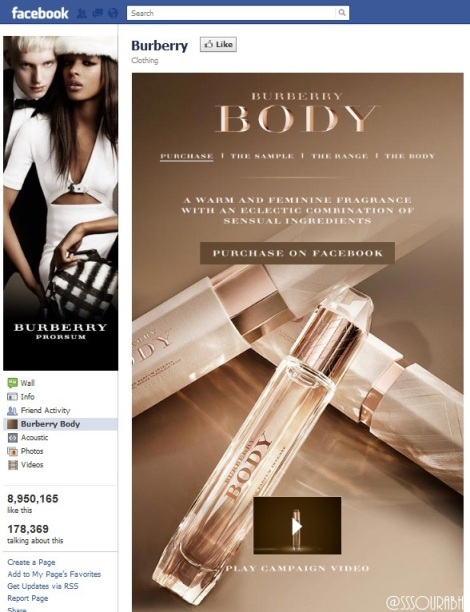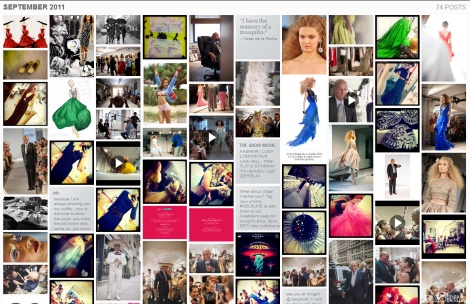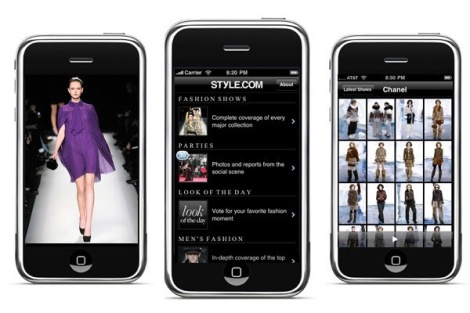Like stars twitching uneasily in the dark sky, countless lights gleam in the darkness of the audience in a fashion show, competing against the bright glare of the runway. Not stars on earth, nor the sparkle of sequins; but these are in fact illuminations of smartphones: taking photos, updating statuses, and doing so much more than classic shutterbugs (which still, naturally exist).
Fashion Weeks for Spring 2012 have astounded me with the level of social media acceptance and usage that has been a catalyst in making fashion so much more accessible. Retailers and designers alike have truly harnessed this power to create nothing short of a racing phenomenon.
Rubbing shoulders with the celebrities, donning the sequins, stilettos and authentic designer cut leather jackets is no longer an aspirational dream for fashion enthusiasts. There was an era when fashion week would only be for the glittering elite and those who tiptoed in amidst shutterbugs and sat precariously like pigeons on an electric wire, well aware that they were being watched.
 Fashion week shows today consist of a construction of minutely segmented moments of a collection, a speech, a look, a sentiment, an accolade and much more, all of which are instantaneously photographed, retweeted, shared on a social media platform, and bulge up to relay a magnanimous sense of real-time brand equity.
Fashion week shows today consist of a construction of minutely segmented moments of a collection, a speech, a look, a sentiment, an accolade and much more, all of which are instantaneously photographed, retweeted, shared on a social media platform, and bulge up to relay a magnanimous sense of real-time brand equity.
 To think fashion week is classically an event for media and buyers, who often forget that the ultimate wearer is the consumer. To that benefit alone, social media can take credit for bringing fashion glitz and glamour straight into the lap of its owner. The mainstream consumer can now scratch the surface of fashion week, and even indulge into wholesome bites of the world of haute.
To think fashion week is classically an event for media and buyers, who often forget that the ultimate wearer is the consumer. To that benefit alone, social media can take credit for bringing fashion glitz and glamour straight into the lap of its owner. The mainstream consumer can now scratch the surface of fashion week, and even indulge into wholesome bites of the world of haute.
And this has been more the case this year than any other.
While fascinating to recap the measures taken by designers and brands alike, my thoughts with the upcoming shopping season is this: how much brand loyalty has it really created?
 Fashion’s Night Out (FNO) is a glittering example of Anna Wintour and Diane von Furstenburg’s economics-class-driven idea to boost consumer spending by engaging customer interaction with their favorite brands and brand endorsers, namely drool-worthy and idolized celebrities who grace the streets in the flesh to share the air with their fans. While shared across 700 countries, it is now an excuse to have a party, with stores carding at entrances and serving cocktails and offering live performances amidst littered clothing and accessories. From Armani Exchange’s tee distressing bargains to Kenneth Cole’s personal kick off amidst paraphernalia, brands lure and endure simultaneously.
Fashion’s Night Out (FNO) is a glittering example of Anna Wintour and Diane von Furstenburg’s economics-class-driven idea to boost consumer spending by engaging customer interaction with their favorite brands and brand endorsers, namely drool-worthy and idolized celebrities who grace the streets in the flesh to share the air with their fans. While shared across 700 countries, it is now an excuse to have a party, with stores carding at entrances and serving cocktails and offering live performances amidst littered clothing and accessories. From Armani Exchange’s tee distressing bargains to Kenneth Cole’s personal kick off amidst paraphernalia, brands lure and endure simultaneously.
Although critics may argue that few shop during FNO, the simple connection with a designer, a celebrity, and a plethora of freebies and memories ensure that the mainstream consumer aspires the fashion icon and brand, and consequently cements the relationship. I feel this is the strongest, most viable reason for the existence of a platform that truly connects.
With Fashion Night Out’s third public outing, brands clamor on twitter and Facebook to ensure that the wireless networks are abuzz with their followers. Take Barbie’s QR code enabled scavenger hunt through Manhattan, for a rewarding gratification of having the city at your touch phone savvy fingertips. Digital marketing has shown to be the Launchpad when targeting the yuppy iPhone and android tugging urbanite. View DKNY’s inventive paper-clad e-vitation, as a blaring example of new times. DKNY is one of many brands that successfully converted followers on social platforms into shoppers. Including myself!
CFDA President Diane von Furstenberg deserves two thumbs up for promoting twitter hash tag equivalents and beckoning New Yorkers to indulge in the conversation, which allowed lucky winners to pick up a fragrance sample two weeks in advance of an official brick and mortar launch at Bloomingdales. Smart eh? And as a police check, there was a crosstab of twitter followings and updates with foursquare check-ins. Forget the walls, even the air has ears.
 Forget the bustling streets and lack of direction; iPhone apps like Lustr and interactive maps (shareable on Twitter and Facebook – stalker friendly or friend-wowing?) all allowed tagging of partner stores as an entry to a fabulous giveaway. It was not the retail brands that attach themselves to the digital fiber optics – from Bendel to Jimmy Choo, the upscale market sensed the current of the circuit, too.
Forget the bustling streets and lack of direction; iPhone apps like Lustr and interactive maps (shareable on Twitter and Facebook – stalker friendly or friend-wowing?) all allowed tagging of partner stores as an entry to a fabulous giveaway. It was not the retail brands that attach themselves to the digital fiber optics – from Bendel to Jimmy Choo, the upscale market sensed the current of the circuit, too.
And the perks of simply fanning or following a brand on Facebook or twitter? If Burberry, one was indeed lucky enough to get one of a gazillion samples of Burberry’s Body scent, launched and sampled on Facebook for its fans. Truly a far cry from makeup caked age-ing and harsh pitched sales folks at department stores who jeered scented cards in passerby faces. Oscar de la Renta raised its ‘likes’ by up to 40% through a similar campaign, exhausting 25,000 samples in 3 days – that’s more than department stores nationwide can do for a single fragrance in a month!
With so much interactive media space, I was envious of my non-Manhattan friends who were enjoying the FNO festivities, albeit in a comforting environment. Livestream drew them to witnessing events in a less sweaty party, all on the laptop. Fashion brand channels offered coverage of their respective concerts, like Janelle Monae for Ralph Lauren or Joss Stone at Nine West. Was the endurance really worth it? I should say yes!
Coming to fashion week, I wondered the worth of standing at the back of a tent, compared to the minute by minute updates of everything from the gleam of the stage to the wardrobe malfunction of a model to the beat of the music, all of which was easily viewable on one’s smartphone, and at a location of choice.
Note to voyeurs: indulge in livestreams.
Note to brands: livestreams can either build your brand equity, or drown it.
 Livestreaming live showers @Gant Photo Courtesy: Gant
Livestreaming live showers @Gant Photo Courtesy: Gant
Oscar de la Renta jumped on the bandwagon this year, following up from the fragrancing campaign, with a rather inventive idea. The designer created a live generating kaleidoscope of all content hash-tagged with #odlrlive premiering as live coverage. Not discriminating on source, this comprised of photos, videos, tweets and texts from editors to bloggers to models (who also tweet before walking the ramp!). Meriting from a first-mover honor on Tumblr, this was a distinguished and buzz generating livestream (which however, Tumblr had to monitor with scrutiny for spam – the s-worded pitfall of social media).
 I personally feel that anything on social media has a rawness, an edginess that much overpowers the seemingly airbrushed gleam and sheen of the web and media coverage of fashion shows. Particularly if this includes an element of backstage costume drama or makeup endeavors. It makes the whole brand seem more relatable, more real. The grainy truthfulness and misaligned pixels generate a sense of assurance that fashion is truly for the consumer viewing these on their laptop screen. Transported on the wings of twitter and tumblr of course, where a plethora of iPhone images flourish like feathers. While fashion week consumes lives of four key cities – New York, London, Paris and Milan – the internet travels space and time to unite borders. (Given the electricity, of course, a fact taken for granted).
I personally feel that anything on social media has a rawness, an edginess that much overpowers the seemingly airbrushed gleam and sheen of the web and media coverage of fashion shows. Particularly if this includes an element of backstage costume drama or makeup endeavors. It makes the whole brand seem more relatable, more real. The grainy truthfulness and misaligned pixels generate a sense of assurance that fashion is truly for the consumer viewing these on their laptop screen. Transported on the wings of twitter and tumblr of course, where a plethora of iPhone images flourish like feathers. While fashion week consumes lives of four key cities – New York, London, Paris and Milan – the internet travels space and time to unite borders. (Given the electricity, of course, a fact taken for granted).
And yet, two weeks after Manhattan’s glittering bustle, are people shopping more? Am I really recalling the great times of brushing shoulders with Bieber, Radcliffe, Klum, and many others? I sway on this pendulum of perhaps and perhaps not. And I’m sure others do too.
The point here is not to educate marketers of harnessing the power of social media for brand equity and loyalty building, nor is it to persuade consumers to jump on the bandwagon to lose life in the process of micro-managing a plethora of brands. It’s simply to depict the evolution of tech-savvy-ness, which has flirtatiously hit the doors of a widely loved phenomenon. Fashion.
 Designer Cutting Up a Model’s Tee, Live
Designer Cutting Up a Model’s Tee, Live
Marketers: Embrace. With passion and evolutionary strategy.
Consumers: Embrace. With anticipation and instant gratification.
May the affair last a lifetime. In real-time.










Pingback: Cravings 2012: The Fashion Horoscope « Food, Fashion & Frameworks·
Pingback: Deconstructing the Fashion Anticipation « Food, Fashion & Frameworks·
Pingback: Meet the Women outside the Tents at NYFW « Food, Fashion & Frameworks·
Pingback: Social Media Habits of 2014 |·
Pingback: Traditions of Luxury Window Shopping, now in a Digital World | 3FS: Food Fashion Frameworks·
Pingback: Return of the Retro Hippie Culture with General Idea at NYFWM | 3FS Lifestyle: Food Fashion Frameworks·
Pingback: Distinct Perceptions of the Modern New York Lifestyle: NYMD at NYFWM | 3FS Lifestyle: Food Fashion Frameworks·